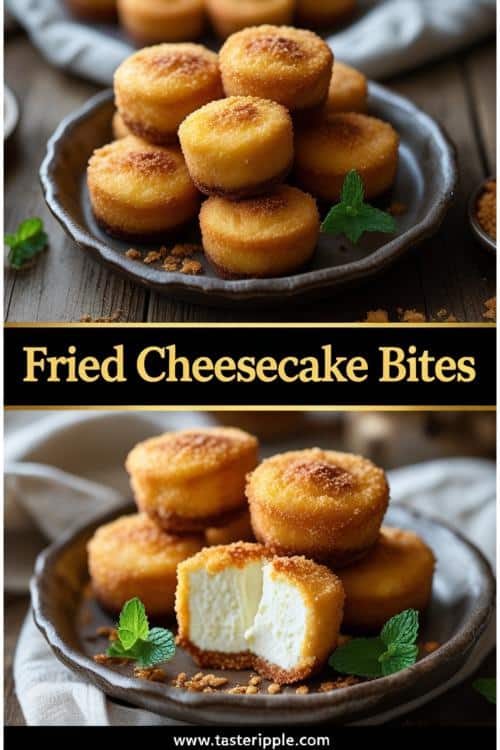You know that feeling when you bite into something that’s crispy on the outside and then the inside just melts away like a secret? That’s exactly what happens with fried cheesecake bites. It’s like a carnival snack that grew up, went to pastry school, and came back dressed in golden crumbs. I still remember the first time I tried them at a small fair in Texas, and honestly, it felt illegal how good they were. Cold, creamy cheesecake suddenly wrapped in hot, crunchy coating—it shouldn’t work, but it does.
What makes fried cheesecake bites so special is that contrast. You have that deep-fried crunch giving way to silky cheesecake filling. It’s not just dessert, it’s a small performance on the tongue. Unlike a slice of cheesecake that asks for patience with its richness, these little bites deliver indulgence in quick punches. They’re casual enough for game nights but also dramatic enough to impress at a plated dessert course if you style them right.
Ingredients and Substitutions
When making fried cheesecake bites, every ingredient matters more than people expect. Cheesecake itself is already rich, so the coating has to balance crispiness without getting greasy. The oil temperature, the type of crumbs, even the cream cheese brand—all these details shift the final result.
Here’s a well-tested list of ingredients for about 20 bites:
| Ingredient | Measurement | Notes & Substitutions |
|---|---|---|
| Cream cheese (full-fat) | 16 oz (2 blocks) | Avoid reduced-fat, it melts too thin. Mascarpone works too. |
| Granulated sugar | ½ cup | Can swap for coconut sugar for caramel notes. |
| Vanilla extract | 1 tsp | Almond extract gives nuttier depth. |
| Egg | 1 large | Helps bind filling. Can omit if cheesecake already baked. |
| Graham cracker crumbs | 1 ½ cups | Digestive biscuits or vanilla wafers also work. |
| All-purpose flour | 1 cup | Gluten-free flour blends work if frying fast. |
| Eggs (for coating) | 2 beaten | Essential for binding crumbs. |
| Milk | 2 tbsp | Whole milk or oat milk both do fine. |
| Oil for frying | 4 cups (neutral oil) | Peanut oil for nutty tone, or canola for clean taste. |
| Powdered sugar | For dusting | Optional, but visually lovely. |
| Chocolate sauce or berry compote | To serve | Adds contrast. |
A quick note on the cream cheese: temperature is crucial. Use it slightly softened so it blends smoothly with sugar, but not warm. Warm cream cheese will never firm up properly for freezing, and that’s the step that decides if your bites hold together or fall apart in the fryer.
For crumbs, graham crackers are classic. They bring a caramel-butter flavor that feels right at home with cheesecake. But don’t ignore alternatives—ginger snaps for spice, Oreos for a chocolate coating, or even ground pretzels if you want that salty edge.
Step-by-Step Instructions
The actual process isn’t hard, but it does demand patience. The freezer is your best friend here, and rushing is what causes leaks and oil explosions.
Step 1: Prepare the Cheesecake Base
Beat cream cheese, sugar, vanilla, and one egg until smooth. If you’ve got a leftover baked cheesecake in the fridge, you can even repurpose slices into this recipe—just scoop and roll them once they’re cold. Professionals often do this with scraps after trimming cheesecakes.
Tip: Don’t overmix. Air bubbles in cheesecake filling cause cracks and uneven texture. Just mix until creamy.
Step 2: Chill and Shape
Spread the filling in a shallow dish and freeze until firm, about 2 hours. Once solid enough to handle, scoop tablespoon portions and roll into small balls. If they soften too quickly, toss them back in the freezer for 10 minutes.
Mistake to avoid: Don’t skip the freezing stage. If the cheesecake is even slightly soft, the coating won’t stick properly and you’ll end up with cheesy oil soup.
Step 3: Dredge and Coat
Set up a breading station: flour in one bowl, eggs whisked with milk in another, and crumbs in a third. Roll each frozen ball in flour, dip in egg, then roll in crumbs. For extra crunch, repeat egg and crumb step. Double coating keeps them sealed.
Variation idea: Add cinnamon sugar to the crumb mix for a churro-style bite. Or crush toasted coconut and fold it in for a tropical version.
Step 4: Frying
Heat oil to 350°F (175°C). Drop in 3–4 bites at a time, no more. Overcrowding crashes the oil temp and causes soggy bites. Fry until golden, about 1½ minutes per batch.
Expert tip: Always check oil recovery time. Use a thermometer—don’t guess. Cheesecake is delicate, so even a 20-degree dip in oil temp makes them absorb grease instead of crisping.
Step 5: Drain and Dust
Lift bites with a slotted spoon and set on paper towels or a wire rack. Dust lightly with powdered sugar if serving sweet, or drizzle with chocolate sauce. These bites don’t wait around—eat them within 15 minutes for best texture.
Cooking Techniques and Science
Why freeze first? Cheesecake filling contains a high fat-to-sugar ratio, which softens quickly when exposed to heat. Freezing turns that filling into a semi-solid, allowing the coating to seal before the inside warms up. If you fry from fridge-temp instead of frozen, you’ll get burst bites with filling leaking into the oil.
Why coat in flour first? That dry layer grabs onto moisture and creates a barrier. Without it, the egg wash would slide off the cold cheesecake surface like rain on glass. That flour is the quiet hero of this recipe.
Why use neutral oil? Because oils with strong flavor profiles—like olive oil—compete with the delicate sweetness of cheesecake. Peanut oil works, but only if you want its nutty accent. Otherwise, canola or sunflower give clean fry results.
Tools That Matter
- A candy thermometer or digital probe for oil temp. Guessing is not professional work.
- A wire rack over a sheet pan to let oil drip without steaming the coating.
- A small cookie scoop for portioning evenly sized bites. Uneven balls fry at different rates.
Storage and Reheating
Now, fried cheesecake bites are at their peak the moment they’re cooked. But sometimes you’ll want to prep ahead. Freeze coated but unfried bites on a sheet pan, then transfer to bags. Fry straight from frozen, just add 30 extra seconds.
Reheating fried ones? Honestly, they’re never as crisp. But if you must, pop them in a 375°F oven for 5–6 minutes. The microwave is a death sentence here, turns the crust limp.
Variations and Substitutions
Vegan version: use dairy-free cream cheese and egg replacers, coat with crushed vegan cookies.
Gluten-free: swap flour and crumbs with gluten-free blends or almond flour.
Spicy version: Add cayenne and chili powder to crumbs for a fiery-sweet twist. Chocolate sauce plus heat is a flavor bomb.
Serving and Pairing Suggestions
Presentation changes the whole vibe. At a fair, you can dust them with powdered sugar and hand them in paper cones. At a dinner party, serve three bites stacked in a crescent on a slate plate, with raspberry coulis drizzled around like brushstrokes. Add mint leaves for freshness.
Pairings? Fried cheesecake bites love contrasts. Black coffee cuts the richness. Bubbly prosecco lifts the heaviness with acidity. If serving at brunch, offer alongside fresh fruit salad—it resets the palate. For late-night snacking, drizzle with bourbon caramel sauce.
Best Time to Serve
These bites shine in moments of indulgence. Midnight snacks, carnival-themed parties, family movie nights. They’re also genius as a holiday dessert because they can be prepped ahead and fried last-minute. The smell alone brings people running into the kitchen.
And don’t underestimate them as plated petits fours. Restaurants often fry them in miniature sizes and serve with espresso, a cheeky finale to a fine meal.
Conclusion
Fried cheesecake bites are the dessert you didn’t know you needed. They’re playful yet technical, indulgent yet portioned, messy but magical. If you treat the oil right, keep the filling frozen, and coat them properly, you’ll get that golden crunch every time.
The key tip? Patience with the freeze and precision with the oil. That’s what separates greasy disappointment from addictive perfection. Experiment with coatings, sauces, and plating—but always respect the science of fat, sugar, and heat.
FAQs
Can I air-fry cheesecake bites instead of deep frying?
Yes, but the texture changes. They won’t get as shatter-crisp, but brushing with oil and air-frying at 375°F for 6–7 minutes gives a lighter option.
Can I use store-bought cheesecake?
Absolutely. In fact, pre-baked cheesecake slices are easier to work with. Just cut into cubes, freeze, and coat.
How do I keep them from falling apart in the oil?
Double coating and freezing solid before frying are non-negotiable. Also, fry in small batches so oil temp doesn’t plummet.
What sauces pair best with fried cheesecake bites?
Chocolate ganache, raspberry coulis, caramel sauce, or even spiced honey. Something tart or bitter helps balance sweetness.
Can I make them savory?
It’s unusual, but yes. Some chefs experiment with savory cheesecake bases (like goat cheese with herbs), then fry and serve with chutneys. It works surprisingly well.

